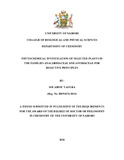| dc.description.abstract | This thesis describes an investigation of two plants from Anacardiaceae plant family namely
Lannea rivae (Chiov) Sacleux and Lannea schweinfurthii (Engl.) Engl. and three other plants
from Asteraceae family; Psiadia punctulata Vatke, Aspilia pluriseta Schweinf. and Aspilia
mossambicensis (Oliv.) Wild for their bioactive principles. Chromatographic separation of
different extracts from the five plants led to the identification of a total of seventy six
compounds among which ten were new, and fourteen derivatives obtained by chemical
derivatization. Three structures wrongly reported in the literature were corrected. The
structure elucidation of the compounds was performed by using Nuclear Magnetic Resonance
(NMR), Ultra Violet (UV), Infra-Red (IR), Optical Rotation (OR) and Mass Spectrometric
(MS) techniques. In the case of seventen compounds X-ray crystallography was used. The
isolated compounds and crude extracts were tested for their cytotoxicity, antimicrobial, antiinflammatory,
antiplasmodial and antidiabetic activities. The root extract of Lannea rivae
resulted in isolation of seven compounds of which the alkenylcyclohexanone derivatives;
(4R,6S)-4,6-dihydroxy-6-((Z)-nonadec-14′-en-1-yl)cyclohex-2-en-1-one (186) and
(2S*,4R*,5S*)-2,4,5-trihydroxy-2-((Z)-nonadec-14′-en-1-yl)cyclohexanone (187) are new.
The known compounds include taraxerol (188), taraxerone (189), β-sitosterol (190),
epicatechin gallate (191), and 3’’,5’’-dimeyhoxy-epicatechin gallate (192). Epicatechin
gallate showed high antimicrobial activity against Staphylococcus aureus and Escherichia
coli, but most of the known compounds isolated from this plant were not effective against the
two strains. From the stem bark of L. rivae, two known compounds were isolated, namely
lupeol (193) and daucosterol (194). Roots extracts of Lannea schweinfurthii resulted in the
identification of seven compounds namely 3-((E)-nonadec-16'-enyl)phenol (195), 1-((E)-
heptadec-14'-enyl)cyclohex-4-ene-1,3-diol (196), 1-((E)-tridecadec-10'-enyl)cyclohex-4-en-
1,3-diol (197), 1-((E)-pentadec-12'-enyl)cyclohex-4-ene-1,3-diol (198), 1-((E,E)-nonadeca-
12',14'-dienyl)cyclohex-4-en-1,3-diol (199), 1-((E)-nonadec-16'-enyl)cyclohex-4-en-1,3-diol
(200) and catechin (201). The stem bark of L. schweinfurthii resulted in the isolation of seven
compounds; 4,4'-diydroxy-3-methoxy-3'-O-glucosyl-ellagic acid (202), 4,4'-dihydroxy-3-
methoxy-3'-O-[rhamnopyranosyl-(1
→2)] rhamnopyranoside ellagic acid (203), 3-
((12'Z,14'E)-heptadeca-dienyl)phenol (204), 188, 189, 195 and 198.
xxii
Phytochemical study of the leaves of Psiadia punctulata led to the identification of twenty
one compounds of which eight are new diterpene: trachyloban-17-oic acid (205), ent-17-
hydroxy-trachyloban-20-oic acid (206), ent-[6β,18,19]-trihydroxy-trachyloban-2-one (207),
normal-trachyloban-2α,18,19-triol (208), normal trachyloban-2α,6α,19-triol (209), ent-
15β,16α,17-trihydroxy-kauran-19-oic acid methyl ester (214) and compounds 219b-c. From
the stem bark of P. punctulata, six compounds were identified. These include 7α-hydroxyent-
trachyloban-19-oic acid (225), friedelan-3β-ol (226), spinasterol (227), (S)-2,3-
dihydroxypropyl tridecanoate (228) and 5-hydroxy-7,2',3',4',5'-pentamethoxy-flavone (220)
and 5,7-dihydroxy-2',3',4',5'-tetra-methoxy-flavone (221). Analysis of the roots of P.
punctulata led to the identification of six compounds; ent-trachylobane-2α,6β,18,19-tetraol
(229), ent-kauren-16-en-2-one (230), friedelin (231), 24,25-dihydro-lanost-8(9)-en-3β-ol
(232), (6R, 7R)-bisabolone (233) and 221. Compounds 207 (CC50=6.41±0.2 μM) and 210
(CC50=3.4 ± 0.1 μM) are the most cytotoxic against Hep-G2 and DU-145 cell lines
respectively. From the roots of Aspilia pluriseta, nine kaurene derivatives; 12α-methoxy-entkaura-
9(11),16-dien-19-oic acid (234) and 16α-hydroxy-ent-kauran-19-oic acid (235), 9β-
hydroxy-15α-angeloyloxy-ent-kaur-16-en-19-oic acid (236), 15α-angeloyloxy-ent-kaur-
16α,17-epoxy-ent-kauran-19-oic acid (237), methyl-9β-hydroxy-15α-angeloyloxy-ent-kaur-
16-en-19-oate (238), 15α-angeloyloxy-ent-kaur-16-en-19-oic acid (239), ent-kaura-9(11),16-
dien-19-oic (240), ent-kaura-9(11),16-dien-12-one (241), methyl-ent-kaur-16-en-19-oate
(242) were isolated. The seven other compounds isolated from the roots are kaurene also
diterpenes derivatives (236-242). The aerial part of A. pluriseta let to the identification of
seven compounds; ent-kaur-16-en-19-oic acid (243), ent-kaur-16-en-19-ol (244), ent-kaur-
16-ene (245), lanosterol (246), stigmasta-5,22(E)-dien-3β-ol (247), 3β-hydroxy-olean-12-en-
29-oic acid (248), carissone (249). Oral glucose tolerance test results revealed that the crude
extract of A. pluriseta reduced the blood glucose level more than any other isolated
compounds. Seven compounds namely methyl-15α-angeloyloxy-ent-kaur-16-en-19-oate
(250), 12-oxo-ent-kaura-9(11),16-dien-19-oic acid (251), ent-kauran-19-oic acid (252), 3β-
hydroxyolean-12-en-28-oic acid (253), 236, 237, 238 were also isolated and identified from
the root of Aspilia mossambicensis (Asteraceae). The aerial part of the same plant, A.
mossambicensis resulted in the identification of β-amyrin acetate (254), kaura-9(11),16-diene
(255), 15β-hydroxy-kaura-9(11),16-diene (256), methyl cinnamate (257), 240, 243 and 247.
xxiii
Ten derivatives (258-267) were prepared from the isolated compounds of Psiadia punctulata.
Four more compounds (268-271) were derivatized from the isolated compounds of Aspilia
pluriseta. Among these derivatives, compound 265 was found to be active (CC50 = 16.9 ± 5.1
μM) against the growth of A549 cancer cell line. Compound 270 was the most antimicrobial
against Staphylococcus aureus, Escherichia. coli and Candida parapsilosis having an
inhibition zone of 8 mm against each strains.
O
HO HO OH
H
H
O
OH
H
H
H
O
OCH3
OH
OH
OH
H 205
214
207
HO O OH
206
HO
HO OH
HO
H
H
HO
OH
208
209
O
OH
OH
O
OH
OH
HO
186
187
OH
O H
H3CO H
235
234
OH
O
O
O
H
H
O
237
N NH
OCH3
OCH3
OCH3
H3CO
OH
OH
H3CO
260
O
O
H3CO
OCH3
OCH3
OCH3
OH
RO
Br
Br
R = OCH3 261
R = H 262
OH
O H
OH
H
1 | en_US |



